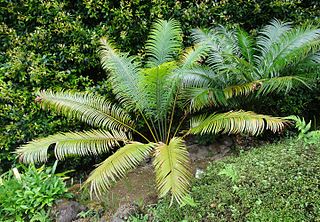Cycas aculeata is a species of cycad in the genus Cycas, native to Vietnam, where it is endemic to a single site on the south slopes of the Hai Van Pass.

Cycas angulata is a species of cycad in the genus Cycas, native to Australia in northeast Northern Territory and northwest Queensland.

Cycas apoa is a species of cycad in the genus Cycas, native to northern New Guinea and Halmahera Island. It occurs in the Sepik River basin, in wet lowland forest in modestly seasonally flooded areas.
Cycas arenicola is a species of cycad in the genus Cycas, native to Australia, in the far north of Northern Territory in the basin of the upper East Alligator River in Arnhem Land. It grows in Eucalyptus woodlands on highly siliceous soils. They thrive in open situations.

Cycas armstrongii is a species of cycad in the genus Cycas, endemic to Northern Territory of Australia. It is found from the Finniss River in the west to the Arnhem Highway in the east, north of Pine Creek. It also occurs on the Tiwi Islands and the Cobourg Peninsula
Cycas arnhemica is a species of cycad in the genus Cycas, native to Australia, in the northwest of Northern Territory in Arnhem Land, after which it is named.
Cycas basaltica is a species of cycad in the genus Cycas, native to Australia, in the far north of Western Australia in the Kimberley region.

Cycas beddomei is a species of cycad in the genus Cycas, native to India, where it is confined to a small area of Andhra Pradesh state in the Tirumala Hills in scrubland and brush covered hills.
Cycas bifida is a species of cycad plant in the genus Cycas, native to southern China, and northern Vietnam.

Cycas bougainvilleana is a species of cycad in the genus Cycas, native to the islands northeast of Papua New Guinea, on New Britain, the Bismarck Archipelago and the Solomon Islands, where it occurs on or near the coast in calcareous coral sand dunes and in adjacent forests.
Cycas brachycantha is a species of cycad in the genus Cycas, native to northern Vietnam where it is endemic to Bắc Kạn Province. It grows in often soil-free cracks and crevices of limestone crests and ridges under the canopy of evergreen forests. It is found in Ba Bể National Park.
Cycas brunnea is a species of cycad in the genus Cycas, native to northern Australia in northwest Queensland and northeast Northern Territory in a small area straddling the border of the two regions. It occurs on exposed sites in savanna and creek valleys on sandstone and limestone derived soils, with moderate seasonal rainfall.

Cycas cairnsiana is a species of cycad in the genus Cycas, native to northern Australia in northern Queensland on the Newcastle Range.
Cycas calcicola is a species of cycad in the genus Cycas, native to northern Australia in the northwest of Northern Territory.
Cycas campestris is a species of cycad in the genus Cycas, native to southeastern Papua New Guinea in the lowland region near Port Moresby. It grows in open, grassy locations, often in areas with frequent grass fires.
Cycas canalis is a species of cycad in the genus Cycas, native to northern Australia in the northwest of Northern Territory, where it occurs in two areas, on the coast at Channel Point, and inland in the Daly River area near Dorisvale.
Cycas chamaoensis is named after the only known habitat of this species, on and near Khao Chamao mountain in Khao Chamao District, Thailand. Stems are arborescent, either erect or decumbent. Leaves numerous, exceeding 60 per crown, 1.2-2.5 meters in length, ending in terminal spine. Petiole 30–60 cm, glabrous and partially spiny. Leaflets in 85-155 pairs, and lanceolate, glabrous and angled forward at 60-70 degrees.

Cycas micronesica is a species of cycad found on the island of Yap in Micronesia, the Marianas islands of Guam and Rota, and The Republic of Palau. It is commonly known as federico nut or fadang in Chamorro. The species, previously lumped with Cycas rumphii and Cycas circinalis, was described in 1994 by Ken Hill. Paleoecological studies have determined that C. micronesica has been present on the island of Guam for about 9,000 years. It is linked with Lytico-Bodig disease, a condition similar to amyotrophic lateral sclerosis (ALS), due to the neurotoxin BMAA found in its seeds, which were a traditional food source on Guam until the 1960s. The neurotoxin is present due to its symbiosis with cyanobacteria.

Macrozamia miquelii, is a species of cycad in the plant family Zamiaceae. It is endemic to Queensland and New South Wales in Eastern Australia. Located within sclerophyll forests dominated by eucalyptus trees, the cycad grows on nutrient-poor soils. It is recognised within the Zamiaceae family for its, medium height at 1 m, intermediate size of male and female cones and lighter green leaves compared to other cycads within the plant family of Zamiaceae. The seeds have an orange red sarcotesta which attracts fauna consumption, allowing a mutualistic seed dispersal for the cycad. These seeds are also edible for human consumption if prepared correctly to remove the toxins.

Cycas rumphii, commonly known as queen sago or the queen sago palm, is a dioecious gymnosperm, a species of cycad in the genus Cycas native to Indonesia, New Guinea and Christmas Island. Although palm-like in appearance, it is not a palm.









